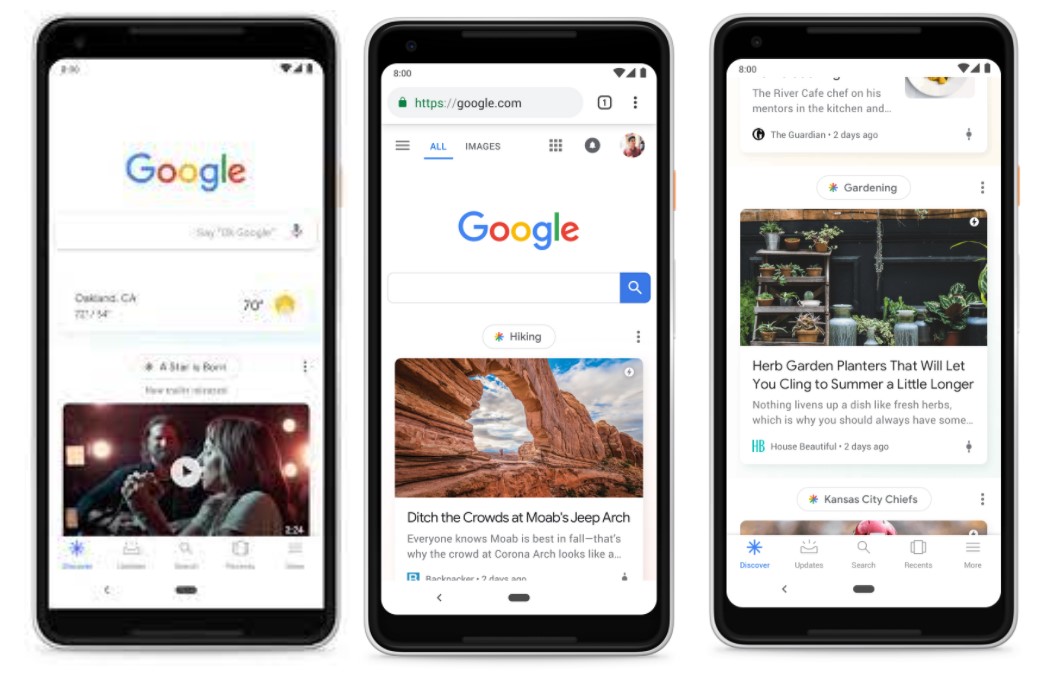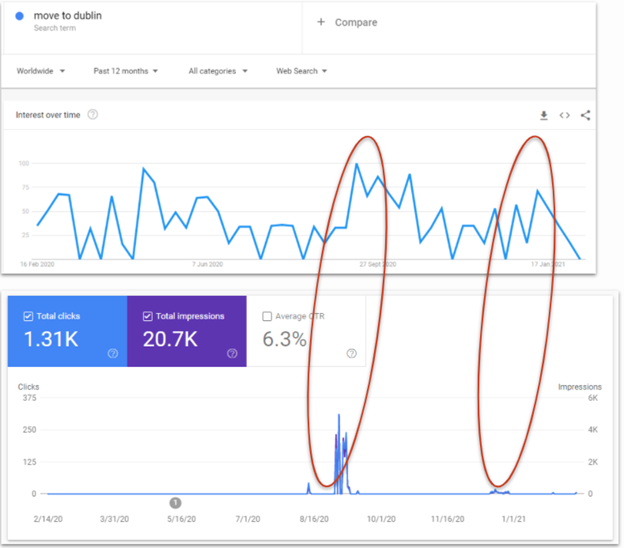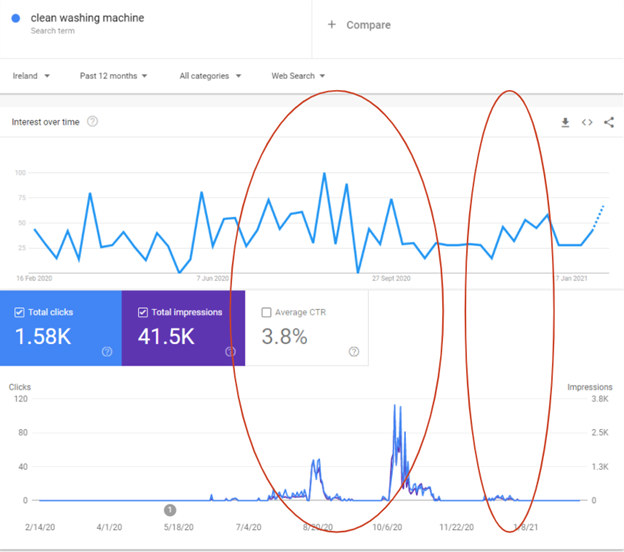By Nicai de Guzman on 12 May 2021
If you’ve used Google lately, you may have noticed some stories suggested for you which are eerily tailored to your taste. This is Google Discover, a feed that appears on your Google app’s home page.

So what's the magic behind Google Discover? And how can you improve your chances of featuring there?
Well, the Content and SEO team at Wolfgang have been deep diving what exactly is at play here and have drawn some interesting and actionable insights that may help you hack this valuable real estate.
What’s Google Discover?
Similar to your social media feed, Google Discover’s feed is also personalised in such a way that you don’t need to enter a search query for these stories to appear. And it's a pretty far-reaching platform. It even features as native on some phone's home pages, such as Samsung’s Galaxy S21 series.
Of course, Google won't feature any old content in its Discover feed. As ever, Google is on the hunt only for the most relevant and trustworthy content, stating in July 2020 that:
“Our automated systems surface content in Discover from sites that have many individual pages that demonstrate expertise, authoritativeness, and trustworthiness”
Never one to stand still, Google has also announced that it is introducing Web Stories, previously known as AMP Stories, to Google Discover. Web Stories offers brands a highly visual storytelling opportunity, allowing you to feature video, images and audio in the SERP. Originally available to a few, select countries including the US, India, and Brazil, Web Stories has since rolled out to more countries in 2021. This means that you can expect the Discover feed to become more visual in nature.
Why Should You Care About Google Discover?
What’s the value of being on Google Discover? The most obvious point here is that being featured on Discover exposes your brand to new, relevant audiences, even before they perform a search. And believe it or not, it can have a significant impact on your organic sessions and conversions and we've got the data to show you!
We examined blog posts on various topics and across multiple clients who were featured on Google Discover. By analysing over 50 blog posts from e-commerce and corporate sites in a span of a year, we have discovered these significant results:
1. Increase in organic sessions
Storage space provider Nesta, saw 10x more organic sessions on their blog about Moving to Dublin when it was featured on Discover. The average sessions it has when not on Discover was just a little over a hundred. It reached over 1,000 when it was on Discover.
Meanwhile, e-commerce sports brand Elverys, saw three times more organic sessions on their blog post Choosing the Right Shoe Size when it featured in Google Discover.
2. Increase in clickthrough rate
Clickthrough rates have also increased for posts featured on Discover. A client in the consumer cybersecurity space saw their blog achieve an average CTR of 4.01% when featured on Discover vs. 2.4% when not on Discover. E-commerce website Littlewoods got 5.2% CTR when featured on Discover vs. 1.6% CTR before Discover. (Note: This is comparing the six-month period before and after being featured on Google Discover.)
3. Increase in conversion rate
Interestingly, it's not only content that can feature on Google Discover. We've seen plenty of product pages appear here too. And when they do, we have seen increases in conversion rates. For our sticker, label, and packaging maker client, we’ve seen a 2.92% conversion rate for their Custom Keychains page vs. 0% when not on Discover and a 3.51% increase for their Holographic Stickers page vs. 2% when not on Discover. So not only is Discover enhancing your visibility and traffic, it's driving highly relevant traffic that's more likley to convert.
How Do You Get on Google Discover?
Now, the question that's surely on your lips: How exactly do you get on Google Discover?
Best practices to make it on Google Discover:
Here are some of the tried-and-tested methods:
- Create an entity in the knowledge graph for you to access Google Discover
- You need evergreen content on a niche within a topic
- Use a hi-res images in line with AMP requirements of 1.200 px for Google News and don't forget alt text
- Optimise for mobile
- Use an informative title that is useful but does not use clickbait approaches.
- Follow the content policy for Google Discover
- Organise content semantically
- Try Web Stories
Why am I still not on Google Discover?
Based on our data, which also seems to be consistent with other studies that have been done on Discover, it only takes about two days before Google Discover “discovers” you. The nature of the post is also a factor in how long your page will stick around on Discover. Current events and news-type of stories get a lot of attention (views, hits) but it’s only for a short period of time (a week at most!)
However, evergreen content seems to be performing better in terms of duration on Discover. Now, what if evergreen content is already part of your strategy? How come your posts are still not being picked up? Don’t worry, we’ve also wondered the same for our blog posts!
When looking at our data, we have noticed that most of the blog posts we have created for our clients are already evergreen...
But why does some content outperform others? When we looked at the blog posts for our client in sports e-commerce, we noticed that some have been featured on Discover for over a hundred days while others remain for less than ten days.
Upon closer inspection, what we have discovered is that it goes back to search volume and intent. The more people search for it, the better the impressions and clicks. For example, one of our stories about measuring shoe size is doing particularly well since that term has got a massive search volume, as seen below:

Another thing that factors in is the “trendability” of topics. We’ve seen from our posts that trending topics affect the featurability of blogs.
As you can see here from our post for our storage unit client, the spike of impressions and visits from Google Discover to our blog matches the timeline of “move to Dublin” keyword spike.

We can say the same thing about our Littlewoods Blog on How to Clean A Washing Machine:

The spike of searches for “clean washing machine” has triggered the blog to be featured and consequently, get impressions and clicks. (We’ve noticed that this spike in searches coincided with a popular show discussing how to clean washing machines!)
The unique blend of something evergreen but also trendy is the perfect combination! So when you’re thinking of publishing a story or perhaps repurposing content, it’s best to upload it when it’s trendy while optimising it to have an evergreen angle. To go back to that “Moving to Dublin” post, while people move to Dublin all the time, it’s more popular around summer and towards the start of the school year when students are moving into the capital.
So, remember: trendy with an evergreen angle plus the usual E-A-T (Expertise, Authority, Trustworthiness) and SEO best practices = Google Discover feature!
We’ve experimented with some of our clients using this formula and though it has worked for some, others still did not get picked up on Discover. However, what we’ve noticed is that the posts that did not get into Discover, still managed to get on the first page of SERP less than a month after publication. Not a bad consolation prize! Just goes to show that if you keep doing the right things on a consistent basis, you're likley to pick up a win!
Google Discover Trends: News vs. Other Websites
As previously mentioned, based on our observation and other studies, news stories (mostly from news sites) easily get on Discover. A news site client had 759 stories featured on Google Discover vs. an e-commerce site that only had 14 posts featured on Discover.
So if you’re not a news site, how can you still leverage Discover? Do e-Commerce and even B2B sites stand a chance? The answer is yes, they do!
Read our tips below…
Google Discover for e-Commerce and Corporate Sites
There’s still a chance to get into Discover even if you're not a publisher or a news site. Here are some of the best practices:
You must have a blog!
Though e-commerce product pages get featured on Discover, having a blog where you can write about informational topics is a big advantage. Our clients who created 'How-To' type content and 'What-Are' explainer posts related to their products and services tended to feature on Google Discover. And if you already have a blog, make sure to audit your content and consistently optimise it, since we know that fresh, timely content is always preferred by Discover.
It was even easier when they were writing about their areas of expertise and found a new angle or unique take on a story! This brings us to the next tip...
Find a content gap
What are your competitors not writing about? Is there a topic they haven’t discussed at length? Is there a niche subject that only you can write about and you are the authority on? These are good questions to ask when you are finding a content gap that perhaps your blog post can fill.
Have strong calls to action tied into the post
Make sure your page also has strong calls to action that are relevant to your post. Make sure your posts are linking to the correct pages. If you are writing a post about shoes for a specific sport, then it should link to shoes for that specific sport. (Hopefully, that page is also indexed!)
Improve the content on product and category pages
Yes, it’s possible for product pages to be featured on Google Discover but they have to have some content on there as well! When we looked at the product pages of our clients who were featured on Google Discover, we noticed that they were all very descriptive and also contained high-resolution images. They even talked about how customers can use the products, as well as product specifications.
On the other hand, competitor pages were not featured and it appeared to be because they were lacking the content that this page has. These pages were bare and lacked the detail that the featured pages have.
Have a content strategy
Your individual blog posts will not mean anything if it’s not part of a bigger SEO-Content strategy that incorporates keyword research and structure. After all, search engines like Google look at your overall website and not just individual posts when deciding whether to feature or rank your pages.
If you'd like to chat about how you can overhaul your SEO-Content strategy to start taking advantage of all the latest opportunities that Google is presenting us with to reach your customers, please reach out to us at [email protected] and ask about our SEO and Content offerings.


.png)
.png)







_2025.png)

